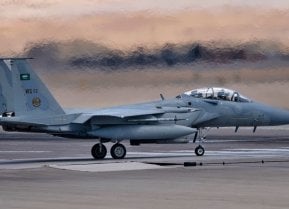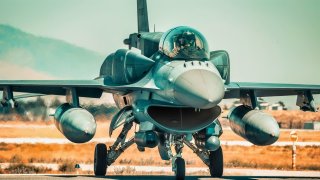The F-16 Fighting Falcon Is a Warplane Plane with No Equal
The fast and agile F-16 Fighting Falcon isn't just one of the top fighters it is also among the most cost-effective.
The F-16 Fighting Falcon in the Spotlight Following South Korean Crash - A United States Air Force F-16 Fighting Falcon experienced an in-flight emergency off the coast of South Korea on Monday. The pilot, who was not identified, was able to eject before the aircraft crashed into the sea, and was reported to be "awake and in stable condition" after being rescued by South Korean maritime forces, the U.S. 8th Fighter Wing said in a statement.
"We are grateful for the safe recovery of our airman by our ROK allies and that the pilot is in good condition,” said Col. Matthew C. Gaetke, 8th Fighter Wing commander, using the initials for South Korea's official name, the Republic of Korea.
The cause of the in-flight emergency is unknown and the incident will be thoroughly investigated. Further details regarding the incident will not be made available until the conclusion of the investigation, the 8th Fighter Wing said in a statement.
The incident comes just weeks after a U.S. military Osprey aircraft crashed into waters off the coast of Japan, killing all eight U.S. airmen on board. Air Force Special Operations Command said Sunday that U.S. Navy divers had recovered the remains of one of the two crew members still missing, NBC News reported.
The F-16 Fighting Falcon – New Aircraft Coming
Despite this latest crash, the F-16 is in no danger of having its wings clipped.
In fact, it was in September 2023 that Lockheed Martin announced that it would ramp up production of its F-16 Fighting Falcons – with those aircraft being earmarked for delivery to Taiwan. It was also just a year ago that the first F-16 of Block 70/72 configurations rolled out of the aerospace and defense giant's Greenville, S.C., facility.
The factory was geared up to build at least 128 more of the Fighting Falcons by the end of the decade.
The Block 70/72 models are equipped with Northrop Grumman's Fifth advanced APG-83 AESA radar that provides fifth-generation fighter radar capabilities by leveraging hardware and software commonality with F-22 and F-35 AESA radars. This further delivers greater situational awareness, flexibility, and quicker all-weather targeting and provides pilots with unprecedented target area detail and digital map displays that can be tailored with slew and zoom features.
The latest version of the time-proven F-16 is also equipped with a new, high-resolution Center Pedestal Display (CPD), which provides critical tactical imagery to pilots and allows them to take full advantage of AESA and targeting pod data.
Old Warbird – But a Proven Aircraft
To date, more than 4,600 aircraft have been built since production of the Fighting Falcon was approved in 1976 – and while it is no longer being acquired by the U.S. Air Force, Lockheed Martin continues to build the F-16 for foreign customers around the world.
It remains the world's most successful, combat-proven multi-role jet fighter ever produced.
The fast and agile F-16 Fighting Falcon isn't just one of the top fighters it is also among the most cost-effective. Though it lacks the range and payload of the larger twin-engine F-15 Eagle, it also costs less than half – which is why the fourth-generation F-16 has been in use since the 1970s and will likely keep flying for many more years to come.
Since it first entered service in 1979, the Fight Falcon has engaged in more than 400,000 combat sorties and has more than a combined 19 million flight hours. Moreover, the F-16 has been adapted to complete several missions, including air-to-air fighting, ground attack, and electronic warfare. As a combat fighter, it has proven to be highly maneuverable while its combat radius exceeds that of its potential threats.
Along with the larger F-15 Eagle, the Fighting Falcon was one of the world's first aircraft to withstand higher g-forces than the pilots. These are notable accolades for an aircraft that really began as a technology demonstrator to determine where it was possible to build a versatile fighter that could be cheaper than the F-15.

Moreover, in designing the F-16, advanced aerospace science and proven reliable systems from other aircraft such as the F-15 and F-111 were selected, the U.S. Force has noted. Those features were combined to simplify the airplane and reduce its size, purchase price, maintenance costs, and weight. The light weight of the fuselage is achieved without reducing its strength. With a full load of internal fuel, the F-16 can withstand up to nine G's – nine times the force of gravity – which exceeds the capability of other current fighter aircraft.
The aircraft entered operational service with the United States Air Force's 34th Tactical Fighter Squadron, 388th Tactical Fighter Wing, at Hill Air Force Base (AFB), Utah, on October 1, 1980 – and that month it achieved combat-ready status.
Author Experience and Expertise
Peter Suciu is a Michigan-based writer. He has contributed to more than four dozen magazines, newspapers, and websites with over 3,200 published pieces over a twenty-year career in journalism. He regularly writes about military hardware, firearms history, cybersecurity, politics, and international affairs. Peter is also a Contributing Writer for Forbes and Clearance Jobs. You can follow him on Twitter: @PeterSuciu.
All images are Creative Commons.


